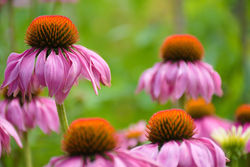16 perennials to add to your cottage garden
- Lars Wildes
- Feb 10, 2023
- 5 min read
Updated: Jun 16, 2023
With their untamed appearance and abundance of blooms, cottage gardens invite visitors to take a step back in time and bask in its simple beauty. The garden itself is a celebration of life, with vibrant colors, fragrant scents, and an informal arrangement of plants. It’s also the style of garden that I love the most.
The key to creating a cottage garden
The key to creating a successful cottage garden lies in its mix of flowers, herbs, and sometimes even vegetables, all grown in an effortless and relaxed style. The trick is to plant with intention, but have it look effortless.
How do you do that? Plant perennials overflowing with color and fragrance. Use plants of different heights, textures, and colors to provide visual interest. Garden paths and walls should be obscured by climbers and trailing plants to create a feeling of wild abandon.
Use garden ornaments, such as birdbaths, containers, benches, and sculptures to add to the whimsical vibe of the garden and provide places for you to relax and take in the beauty of the space you’ve created.
But all of that starts with the plants you choose. Here are my top suggestions for perennials that match the cottage garden style.
Best perennials for a cottage garden
Peony (Paeonia)

Height: 60-90 cm (24-36 inches)
Sun exposure: Full sun
Soil type: Well-drained, fertile soil
Blooms: May to June
Phlox (Phlox paniculata)

Height: 60-90 cm (24-36 inches)
Sun exposure: Full sun to partial shade
Soil type: Well-drained, fertile soil
Blooms: June to August
Delphinium (Delphinium spp.)

Height: 90-120 cm (36-48 inches)
Sun exposure: Full sun
Soil type: Well-drained, fertile soil
Blooms: June to August
Lilac (Syringa vulgaris)

Height: 2-4 m (6-12 feet)
Sun exposure: Full sun
Soil type: Well-drained, fertile soil
Blooms: May
Foxglove (Digitalis purpurea)

Height: 90-120 cm (36-48 inches)
Sun exposure: Partial shade
Soil type: Well-drained, fertile soil
Blooms: June to August
Salvia (Salvia spp.)

Height: 60-90 cm (24-36 inches)
Sun exposure: Full sun
Soil type: Well-drained, fertile soil
Blooms: June to September
Iris (Iris spp.)

Height: 60-90 cm (24-36 inches)
Sun exposure: Full sun to partial shade
Soil type: Well-drained soil
Blooms: May to June
Campanula (Campanula spp.)

Height: 30-60 cm (12-24 inches)
Sun exposure: Full sun to partial shade
Soil type: Well-drained, fertile soil
Blooms: June to August
Veronica (Veronica spp.)

Height: 30-60 cm (12-24 inches)
Sun exposure: Full sun to partial shade
Soil type: Well-drained, fertile soil
Blooms: June to September
Lavender (Lavandula spp.)

Height: 30-60 cm (12-24 inches)
Sun exposure: Full sun
Soil type: Well-drained, gravelly soil
Blooms: June to August

Height: 150-300 cm (60-120 inches)
Sun exposure: Full sun
Soil type: Well-drained, fertile soil
Blooms: June to September
Columbine (Aquilegia spp.)

Height: 30-60 cm (12-24 inches)
Sun exposure: Full sun to partial shade
Soil type: Well-drained, fertile soil
Blooms: May to June
Hydrangea (Hydrangea macrophylla)

Height: 75-100 cm (30-39 inches)
Sun exposure: Partial shade to full sun
Soil type: Moist, well-drained soils
Blooms: Late spring to early summer

Height: 60-90 cm (24-35 inches)
Sun exposure: Full sun to partial shade
Soil type: Well-drained soil
Blooms: Summer
Coral Bells (Heuchera spp.)

Height: 20-50 cm (8-20 inches)
Sun exposure: Part shade to full sun
Soil type: Moist, well-drained soil
Blooms: Spring to summer

Height: 30-100 cm (12-39 inches)
Sun exposure: Full sun
Soil type: Well-drained soil
Blooms: Spring to summer, with spikes of blue, purple, pink, yellow, or white flowers
Bonus plants for every cottage garden
Hardy Geranium (Geranium spp.)

Hardy geraniums are often overlooked in cottage gardens, but they add a beautiful pop of color and texture with their delicate, five-petaled flowers in shades of pink, blue, and purple. Hardy geraniums are also low maintenance and easy to grow, thriving in well-drained soil and partial sun to full shade.
Daylilies (Hemerocallis spp.)

Daylilies are a classic cottage garden plant, but most people expect to see them in sunny, mixed borders, not in shady cottage gardens. However, many daylily varieties thrive in shady locations, providing a burst of color in the garden when other plants may struggle.
Ferns (Polypodiaceae spp.)

Ferns are typically associated with damp, shady woodlands, but they can also be used to create a lush and tropical feel in a cottage garden. Choose a variety of ferns with different textures, shapes, and sizes to add interest and depth to your garden.
Ornamental Grasses (Poaceae spp.)

Ornamental grasses are often seen in modern gardens, but they can also add movement, texture, and interest to a traditional cottage garden. Choose a variety of grasses that work with your garden's light and soil conditions, and group them in large clumps for the best effect.
Clematis (Clematis spp.)

Clematis is another plant that is often seen in modern gardens, but it also adds a touch of whimsy to a cottage garden. With their large, showy flowers in shades of pink, blue, purple, and white, Clematis can climb up trellises, fences, and walls, adding vertical interest and beauty to your garden.
Hostas

Most people expect to find traditional cottage garden plants like Peonies, Roses, and Lavender in a cottage garden, but one plant that may come as a surprise is the Hosta (Hosta spp.).
Hostas are usually associated with shade gardens, but they can also thrive in a cottage garden environment, especially in partial shade. With their large, lush leaves in shades of green, blue, and variegated, Hostas add a touch of elegance to any garden. They also come in a range of sizes, from tiny, dwarf varieties to large, architectural specimens, making them a versatile choice for any cottage garden.
Hostas are also low maintenance, requiring little more than regular watering and a yearly dose of compost or slow-release fertilizer. They are also deer and rabbit resistant, making them a great choice for gardens that border forests and open fields.
How to create a cottage garden
Choosing the right location
The location of your cottage garden is key to its success. A spot that receives at least six hours of sun per day and has well-drained soil will provide the best growing conditions for your plants. It's also a good idea to choose a location that is easily visible from your home or outdoor living areas, so you can enjoy your garden to the fullest.
Planning your garden
When planning your cottage garden, consider the size and shape of your yard and the amount of sun and shade in different areas. Choose plants that will thrive in your location and consider their height, width, and bloom time when arranging them in your garden. A mix of tall, medium, and short plants will create a balanced and visually appealing garden.
Preparing the soil
Preparing the soil is a crucial step in creating a successful cottage garden. To ensure your plants will have the right growing conditions, test your soil to determine its pH level and add any necessary amendments. Turn the soil to a depth of at least 30 cm (12 inches) to loosen it up and remove any weeds. If your soil is heavy or clay-like, consider adding organic matter, such as compost or peat moss, to improve drainage and fertility.
Planting your garden
When planting your cottage garden, group plants together in large drifts, rather than neat rows. This will create a more natural, informal look. Consider planting taller plants in the back of your garden, shorter plants in the front, and trailing plants along the edges. Space plants adequately so they have room to grow and spread but don't be afraid to plant them close together for a lush and full look.
Mulching
Mulching around your plants can help retain moisture and suppress weeds, which will save you time and effort in the long run. Choose an organic mulch, such as shredded leaves, bark, or straw, and spread it around your plants to a depth of 5-7 cm (2-3 inches).
Watering
Regular watering is essential for the health and growth of your cottage garden plants. Water deeply once a week, or more often during hot and dry weather, to ensure the roots of your plants receive enough moisture. Avoid overhead watering, as this can encourage the growth of fungal diseases. Instead, water at the base of your plants, and be sure to not water too much, as overwatering can cause root rot.






Comments